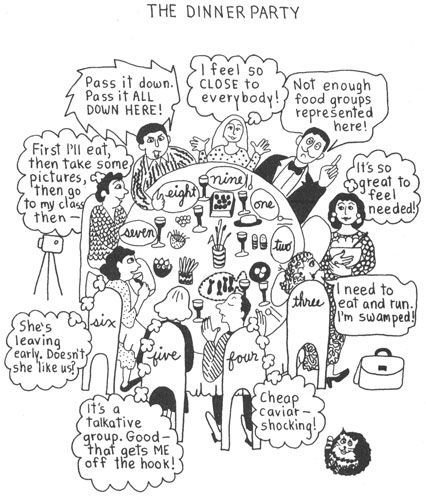To Liz (a Five) for all the years of laughter and friendship, and for your ability to get to the kernel of truth in your writing. To my children: Jodi, Tami, and Dan, and to my friends, with thanks for your love and support. With gratitude to the Twelve-Step community and the guidance of my Higher Power . Renee To Renee (a Two) for your friendship, wit, and knowledge, and most of all for your honesty. Also to my family: Gus, Nick, Martha, Augie, and Miranda, and friends. Thanks for your help .
Liz This book was illustrated by Liz with Renee looking over her shoulder and is proof that any two people can work together using the Enneagram.
The Enneagram is a study of the nine basic types of people. It explains why we behave the way we do, and it points to specific directions for individual growth. It is an important tool for improving relationships with family, friends, and co-workers. The roots of the Enneagram go back many centuries. Its exact origin is not known, but it is believed to have been taught orally in secret Sufi brotherhoods in the Middle East.
The Russian mystical teacher G. I. Gurdjieff introduced it to Europe in the 1920s, and it arrived in the United States in the 1960s.  The Enneagram (pronounced ANY-a-gram) system is represented by a circle containing a nine-pointed starlike shape. Ennea is Greek for the number nine, and gram means a drawing. Enneagram means a drawing with nine points.
The Enneagram (pronounced ANY-a-gram) system is represented by a circle containing a nine-pointed starlike shape. Ennea is Greek for the number nine, and gram means a drawing. Enneagram means a drawing with nine points.
The Enneagram teaches that early in life we learned to feel safe and to cope with our family situations and personal circumstances by developing a strategy based on our natural talents and abilities.  By working with the Enneagram we develop a deeper understanding of others and learn alternatives to our own patterns of behavior. We break free from worn-out coping strategies and begin to see life from a broader point of view.
By working with the Enneagram we develop a deeper understanding of others and learn alternatives to our own patterns of behavior. We break free from worn-out coping strategies and begin to see life from a broader point of view.  People of the same type have the same basic motivations and view the world in some fundamentally similar ways. Variations within each type stem from such factors as maturity, parents types, birth order, cultural values, and inherent traits such as being naturally introverted or extroverted.
People of the same type have the same basic motivations and view the world in some fundamentally similar ways. Variations within each type stem from such factors as maturity, parents types, birth order, cultural values, and inherent traits such as being naturally introverted or extroverted.  As you learn the Enneagram, you will readily begin to type people you know.
As you learn the Enneagram, you will readily begin to type people you know.
We urge you to keep your guesses to yourself and to keep an open mind. Deciding ones type accurately is important and must be done by each person according to his or her own internal perception.  It may be a comfort to know that millions of people have the same coping strategy as you. The behavior patterns that emerge from the nine types are, however, as numerous, mysterious, and unique as the individuals involved. Moving Around the Enneagram 1. The Enneagram Drawing The nine points on the circumference of the circle are divided into a triangle and a six-pointed shape:
It may be a comfort to know that millions of people have the same coping strategy as you. The behavior patterns that emerge from the nine types are, however, as numerous, mysterious, and unique as the individuals involved. Moving Around the Enneagram 1. The Enneagram Drawing The nine points on the circumference of the circle are divided into a triangle and a six-pointed shape:  2.
2.
The Arrows Each point on the Enneagram connects to two other points. These two points or types are called your arrows. When relaxed, you take on the positive qualities of the number that connects to yours in this order: 1-7-5-8-2-4-1 and 3-6-9-3. One goes to Seven, Seven goes to Five, and so on. When under stress, you reverse directions: One takes on the negative qualities of Four, Four of Two, and so on.  3.
3.  3.
3.
The Wings Your personality may blend into or be influenced by the types on either side of yours. For instance, a Nine may have some characteristics of a One or an Eight. These neighboring types are called your wings.  Some people seem to have been different types as children than as adults. Usually these types are related by the arrows or wings. A Brief Description of the Nine Types 1.
Some people seem to have been different types as children than as adults. Usually these types are related by the arrows or wings. A Brief Description of the Nine Types 1.
Perfectionists are realistic, conscientious, and principled. They strive to live up to their high ideals. 2. Helpers are warm, concerned, nurturing, and sensitive to other peoples needs. 3. 4. 4.
Romantics have sensitive feelings and are warm and perceptive. 5. Observers have a need for knowledge and are introverted, curious, analytical, and insightful. 6. Questioners are responsible, trustworthy, and value loyalty to family, friends, groups, and causes. 7. 7.
Adventurers are energetic, lively, and optimistic. They want to contribute to the world. 8. Asserters are direct, self-reliant, self-confident, and protective. 9. Peacemakers are receptive, good-natured, and supportive.
They seek union with others and the world around them. The Three Centers Finding your center is a key to finding your type. Each center is made up of three adjacent types, corresponding to the three centers of the body: the heart, the head, and the gut. The Heart or Feeling Center (Image) Helpers (Twos) are interested in people and in nurturing. They want to present a loving image. Achievers (Threes) like to be seen in a good light, according to socially agreed-upon norms.
Romantics (Fours) have strong needs to express themselves and to be seen as original.  The Head or Thinking Center (Fear) Observers (Fives) rely on their own resources and find safety in knowledge. Questioners (Sixes) seek relief from fear through the permission and approval of authority figures or through rebelling against authority. Adventurers (Sevens) are active and optimistic. They shun unpleasant emotions, including fear.
The Head or Thinking Center (Fear) Observers (Fives) rely on their own resources and find safety in knowledge. Questioners (Sixes) seek relief from fear through the permission and approval of authority figures or through rebelling against authority. Adventurers (Sevens) are active and optimistic. They shun unpleasant emotions, including fear.  The Gut or Instinctive Center (Anger) Asserters (Eights) present a strong image and are not afraid to express their anger.
The Gut or Instinctive Center (Anger) Asserters (Eights) present a strong image and are not afraid to express their anger.
Peacemakers (Nines) are agreeable, accommodating, and can often be out of touch with their anger. Perfectionists (Ones) see anger as a character flaw and try to hold it back. They follow standards of behavior closely and/or try to better the world. 
















 The Enneagram (pronounced ANY-a-gram) system is represented by a circle containing a nine-pointed starlike shape. Ennea is Greek for the number nine, and gram means a drawing. Enneagram means a drawing with nine points.
The Enneagram (pronounced ANY-a-gram) system is represented by a circle containing a nine-pointed starlike shape. Ennea is Greek for the number nine, and gram means a drawing. Enneagram means a drawing with nine points. By working with the Enneagram we develop a deeper understanding of others and learn alternatives to our own patterns of behavior. We break free from worn-out coping strategies and begin to see life from a broader point of view.
By working with the Enneagram we develop a deeper understanding of others and learn alternatives to our own patterns of behavior. We break free from worn-out coping strategies and begin to see life from a broader point of view.  People of the same type have the same basic motivations and view the world in some fundamentally similar ways. Variations within each type stem from such factors as maturity, parents types, birth order, cultural values, and inherent traits such as being naturally introverted or extroverted.
People of the same type have the same basic motivations and view the world in some fundamentally similar ways. Variations within each type stem from such factors as maturity, parents types, birth order, cultural values, and inherent traits such as being naturally introverted or extroverted.  As you learn the Enneagram, you will readily begin to type people you know.
As you learn the Enneagram, you will readily begin to type people you know. It may be a comfort to know that millions of people have the same coping strategy as you. The behavior patterns that emerge from the nine types are, however, as numerous, mysterious, and unique as the individuals involved. Moving Around the Enneagram 1. The Enneagram Drawing The nine points on the circumference of the circle are divided into a triangle and a six-pointed shape:
It may be a comfort to know that millions of people have the same coping strategy as you. The behavior patterns that emerge from the nine types are, however, as numerous, mysterious, and unique as the individuals involved. Moving Around the Enneagram 1. The Enneagram Drawing The nine points on the circumference of the circle are divided into a triangle and a six-pointed shape:  2.
2. 3.
3.  Some people seem to have been different types as children than as adults. Usually these types are related by the arrows or wings. A Brief Description of the Nine Types 1.
Some people seem to have been different types as children than as adults. Usually these types are related by the arrows or wings. A Brief Description of the Nine Types 1. The Head or Thinking Center (Fear) Observers (Fives) rely on their own resources and find safety in knowledge. Questioners (Sixes) seek relief from fear through the permission and approval of authority figures or through rebelling against authority. Adventurers (Sevens) are active and optimistic. They shun unpleasant emotions, including fear.
The Head or Thinking Center (Fear) Observers (Fives) rely on their own resources and find safety in knowledge. Questioners (Sixes) seek relief from fear through the permission and approval of authority figures or through rebelling against authority. Adventurers (Sevens) are active and optimistic. They shun unpleasant emotions, including fear.  The Gut or Instinctive Center (Anger) Asserters (Eights) present a strong image and are not afraid to express their anger.
The Gut or Instinctive Center (Anger) Asserters (Eights) present a strong image and are not afraid to express their anger.